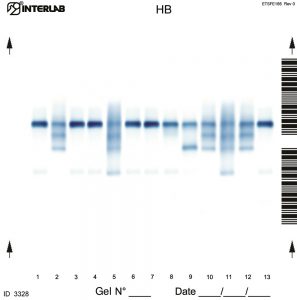

| REF | DESCRIPTION | SAMPLES PER GEL | TEST PER KIT |
|
|
|---|---|---|---|---|---|
| SRE646K | ALKALINE HEMOGLOBINS ELECTROPHORESIS KIT | 6 | 60 | ||
| SRE604K | 13 | 130 |
The Alkaline Hemoglobin Electrophoresis test kits are intended for the in vitro diagnostic use for the separation of normal hemoglobins (A1, A2 and F) as well as certain abnormal or variant hemoglobins (S or D and C or E) using agarose gel. To distinguish hemoglobins S from D or C from E an alternate confirmatory test such as acid hemoglobin electrophoresis is necessary. The electrophoretic test is performed at alkaline pH and provides a valuable screening method for hemoglobin patterns. Densitometry of the pattern allows the relative quantification of hemoglobin bands. The kits have been designed for use with the fully automated instruments Easy Interlab 26 & Pretty Interlab.

Reagent Preparation:
All reagents ready to use.
Sample Preparation:
After the red blood cells (RBC) are washed, they are lysed as follows: 50 μl of packed washed RBC + 200 μl of lysing solution.
Sample Storage & Stability:
Whole blood: 1 week at 2 to 8°C
Hemolysate: 12 hours at 2 to 8°C
In the red blood cells of a normal adult three different types of hemoglobin exist. HbA is the major type with small amounts of HbA2 and HbF. The two mutant hemoglobins most commonly seen are HbS and HbC (Hb Lepore, Hb Bart’s, HbH, HbE, HbG-Philadelphia, HbD-Los Angeles, and HbO-Arab may be seen less frequently).
The alkaline hemoglobins electrophoresis test system is intended for the separation of normal hemoglobins (HbA and HbA2) as well as certain abnormal or variant hemoglobins (HbS or HbD, and HbC or HbE). However, some abnormal and normal hemoglobins may co-migrate (for example, HbA2 and HbC; and HbS and HbD).
Hemoglobins with identical mobility can be differentiated by hemoglobin electrophoresis test run at acid pH. Acid hemoglobins electrophoresis allows separation of these hemoglobins to confirm the identity of clinically relevant hemoglobins such as HbA, HbF, HbS and HbC.
Hemoglobinopathies comprise a large number of hereditary disorders that can produce either qualitative modification of hemoglobin structure, or quantitative variations of hemoglobin synthesis, this eventually leads to an imbalance of the normal concentration of the different types of hemoglobins.
The term Thalassemia refers to a group of diseases (also called syndromes) with similar clinical effects, whose main biochemical feature is the imbalance between the synthesis rate of one type of globin chain and that of its mate. Globin chain imbalance damages and destroys red cells leading to anemia.
